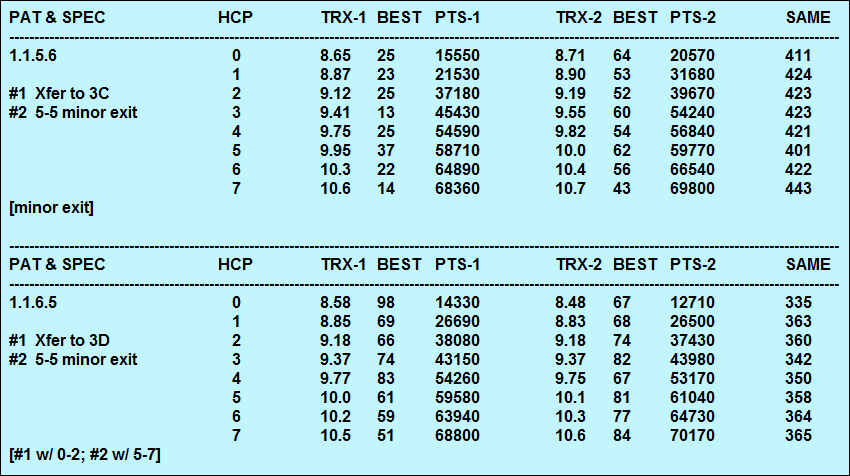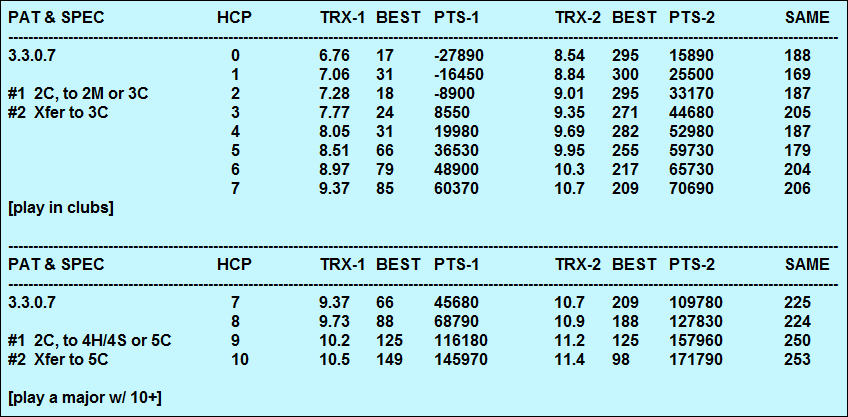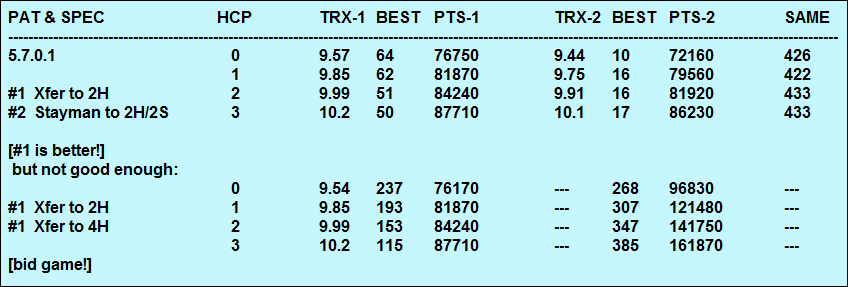

 |
 |
Responding to Notrump with Bad Hands — page 3
6-3-2-2
There are no viable options here. Simply transfer to the long suit.
6-3-3-1
With support for both majors, perhaps that is worth investigating.

Nope. The long suit's control-value is too important with weaker hands. (It so happens that the majors become standout contracts with better hands, but that's the stuff of a different study. Several simulations of this phenomenon are included in the data, however.)
6-4-2-1
With a 6-card major, the decision is easy. With the long minor,
however, it could well be worth trying for a 4-4 major fit.

Wow! It is overwhelmingly best to try for the major.
This fact exemplifies that aforementioned major gap in most players'
methods — that their systems won't enable them to handle
this pattern to best advantage.
In absence of suitable methods, perhaps we should simply transfer to the major:

Nope. Just play in the minor with less than game-going strength.
6-5-x-x
Is it worthwhile to forgo a known 6-2 or better minor-suit
fit in order to hunt for a potentially better fit in the other minor?

Yes it is. In fact, you will not be far off just to implement your
pick-a-minor exit for all hands.
The major-minor combinations are a different story:

Play in the major! Not even close. More tricks are won in the minor contracts, but it doesn't matter.
What about both majors? The winning strategy is to do the same as
with some 5-4 in the majors; that is, trot out Garbage
Stayman with 5-6, but transfer to spades with 6-5.
Results were not significantly different with 6-5-2-0 hands.
7-2-2-2
Naturally, one always wants to play in a 7-card major, at least
below the slam-level. With this pattern, is is best to force to game
with 5+ hcp.
If the suit is a minor, playing in the minor is better than gambling in notrump.
7-3-2-1
This pattern plays better than the balanced hand. Bid game
in the long major with 4+ hcp; otherwise, play a partial.
7-3-3-0
This pattern is rather powerful. How much does it take to make a game?

So game is odds-on with 7+ hcp.
But is that the end of the story? Is it possible that a
major-suit contract would score better?

The answer is: it depends. Holding 10+ hcp, a 4-3 major fit
will outscore the minor-suit game at matchpoints. Of course,
with that much strength, slam in the minor becomes a real possiblity; otherwise,
it is best to languish in the minor-suit game along with everybody else.
7-4-1-1
With a long major, 3+ hcp is enough to try a game contract. But what
if the 4-card suit is the only major? Is it worth trying for?

You bet. If partner fits the major, go for it. Bid game in the
major with 4+ hcp.
It's all the same with 7-4-2-0.
7-5-1-0
Anything might be right with such extreme distribution.
With a 5-card major, should one play there, or in the 7-card minor?

Despite the length of the minor, major-suit contracts are the overwhelming matchpoint winners.
But is a part-score good enough?

With 3+, the odds are greatly in favor of just transferring to game in the major! As before, however, don't have too much stuff, or a slam could be missed.
What if the hand has both majors? This final chart has the answers:

There is no surprise here; it always is best to play in the long suit with a poor hand. What was not so clear before is that one should bid game every time!

But what have we been talking about? Games? Slams?
This is supposed to be a discussion of weak hands; but highly distributional
ones simply aren't so weak. In seems reasonable to end the study here
at the 7-5 level, and perhaps we have gone too far already.